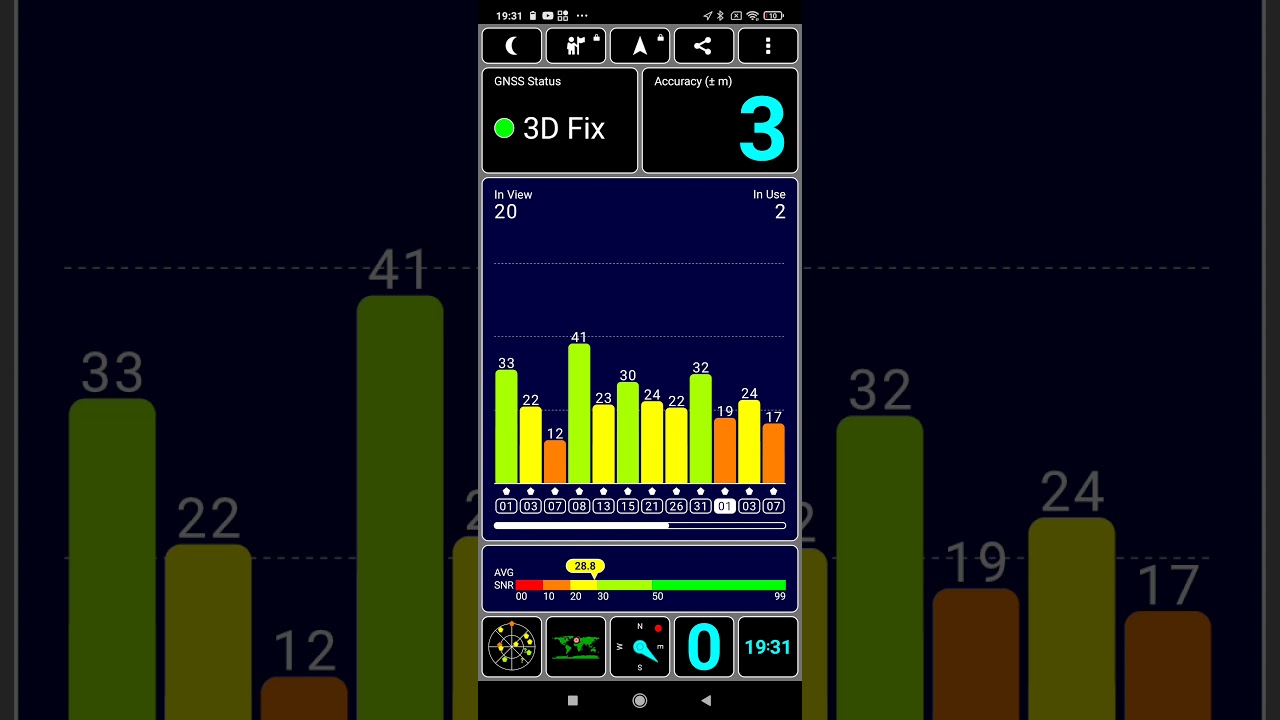Smartphones
Poco F3 Test / Review
Published on: 24-03-2021 / Modified: 11-12-2022
The Poco brand remained for 2 to 3 years in the refrigerators at Xiaomi but this changed in 2020 with the launch of 3 models to cover the entry level (M range), the mid range (X range) and the top range (F range). If we follow the logic of the models that appeared in 2020, the Poco F3 should be classified in the high end as was the case for the Poco F2 Pro but Xiaomi seems to want to position it for a public looking for performance above all there. where the F2 Pro was aiming wider.
The Poco F3 is positioned as a performance beast (to use Xiaomi / Poco's words) and it should be the first phone to exceed 600,000 Antutu points in my ranking. With this kind of performance, the Poco F3 will become the most powerful phone in its price range. Power to do what? Mainly for playing and using heavy applications. Phones like the Redmi Note 10 Pro already allow comfortable gaming, the Poco F3 should offer the ultimate gaming experience.
Apart from this performance, the Poco F3 does not shine with its sound. originality. It swapped the camera in pop mode for a small punch, it is very similar in size and format to the Redmi Note 10 Pro and most of the specs (apart from performance) are similar to other phones Xiaomi and Poco. How is it going to stand out? It is a Poco, it is therefore on its quality / price ratio that it will stand out, it will settle in the mid-range by crushing the competition with a lower price by offering better performance.
Is the Poco F3 only intended for gamers? No, it targets gamers but it is a complete phone that will appeal to a very large audience, its design is more neutral than the X range which is also gamer oriented.
Manufacturer web site:
https://www.po.co/global/
Site where I have bought the Poco F3: https://s.click.aliexpress.com/e/_9I7Buk
Structure of my tests
I test the phones according to a pre-established structure (see below) to provide you with as much information as possible. Unfortunately, this takes a long time. Some tests like network performance tests take several days and for photo tests I sometimes have to wait until the weather is suitable to take pictures in good conditions. I am therefore obliged to publish the tests step by step, so I invite you to come back if the test is not complete at the time of your visit.Price Poco F3
The list below shows the prices for the Poco F3 from more than 50 sites around the world. If you are not satisfied with any price, you can subscribe to a price alert to be the first to be notified when the price drops.The above links are affiliate links from companies such as Amazon, Gearbest, Aliexpress,... If you appreciate my work, I would be grateful if you could purchase these products through these links. It costs you absolutely nothing but I get a small commission that allows me to buy the material I test. Thank you very much!
Timeline
April 01, 2021 purchase of Poco F3 on AliexpressApril 02, 2021 I cancel my order on Aliexpress because I found cheaper on Amazon
April 02, 2021 purchase of Poco F3 on Amazon
April 12, 2021 reception of the Poco F3, the test can start
Why this phone?
Since I buy most phones on launch day, I have to make a blind purchase and trust my instincts. Sometimes I will make the right choice, sometimes not, that's life. Poco and Xiaomi are rather to be classified on the side of the good choices because even if they do not market innovative (or different) phones, they have always managed to launch complete phones at ultra competitive prices. The more well-known brands like Samsung or Huawei will lose a little more ground in the face of this new invasionThe Poco F3 is performance oriented, I am not in the target audience for this kind of phone Because I hardly ever play with my phone, I have always found that the experience on a small screen was not immersive enough. Fortunately this phone, it was also the case of the Poco X3, is doing well on many other criteria and performance becomes a secondary choice.
If I follow the logic of Xiaomi / Poco, I imagine that the F3 will be followed by an F3 Pro which will focus on the photo but in the meantime, let's already see what this F3 has in the belly.
Unpacking
First configuration
The configuration of Poco / Xiaomi follows strictly the same path with always at the end the same attempt to register for the Xiaomi cloud. If the subject interests you, I detailed it in my other tests.Finish
Specifications
The information below comes from the Device Info HW application. The application provides detailed technical information about the tested phone.The Poco F3 is a war machine, it is equipped with a powerful processor, fast memory, an Amoled screen, it is 5G, ... in short, if you had to tick boxes to list what you can find better in a phone, I could tick most of the boxes for this Poco.
The Poco F3 is equipped with a 120hz Amoled Samsung screen, it produces Dolby Atmos sound and its performance is not limited to the power of the CPU or GPU. The Poco F3 uses UFS 3.1 memory like the Poco X3 Pro and this type of memory is up to twice as fast as most phones sold in the same price range. This memory performance brings real benefits on a daily basis because loading applications or accessing files (photos, videos, etc.) is much faster.
To contain these high performance components, Poco has equipped the F3 with a liquid cooling system to better dissipate heat and it works pretty well because after passing the Antutu performance test, the temperature had not risen by more than 7 ° C and I never had an unpleasant feeling of heat as is the case with the Samsung Galaxy S20.
The battery has a slightly below average capacity, which is probably also one of the reasons for the thinness and lighter weight of the phone. If the screen is very bright, it will have a negative influence on the battery, but I still have to test the battery.
CPU / GPU Performance
The Poco F3 is based on a Qualcomm Snapdragon 870 CPU to deliver very high level performance, we find this CPU in other phones but the Poco F3 is undoubtedly the most affordable of all.
For the graphics part, the Poco F3 uses a Qualcomm Adreno 650 GPU and here too it delivers very high level performance and the combination with the CPU places this Poco F3 among the most popular phones. more powerful of the moment. The price / performance argument has also become the main purchase argument for this Poco, you probably won't find such a powerful phone for this price.
Benchmark Antutu/3DMark
You've no doubt seen that the marketing of the Poco F3 was all about its performance, is it just marketing or is this phone really a performance machine? I'm not going to make the suspense go on, it's the most powerful phone I've tested. I got a better score for the CPU with the Poco F2 Pro but on all other criteria, the Poco F3 leaves the competition behind, it performs better than a Samsung Galaxy s20 and heats up significantly less!Gaming
To test the performance in game, I download the mobile PUBG game and evaluate the in-game experience, graphics level and depth of vision. This game is quite demanding and should help you evaluating the performance of a phone.

Since I suck at Fortnite and don't survive more than two minutes in the game, I went into spectator mode to show people who know how to play by demonstrating Poco F3 to provide a very good gaming experience.


Network performance
The Poco F3 is launched at the same time as the Poco x3 Pro. Both of these phones support 5G but the level of frequency coverage is much better on the Poco F3. The X3 Pro only covers a single 5G frequency where the Poco F3 supports 10 5G frequencies. The Poco F3 therefore appears to be a better choice for those with access to 5G. The frequencies offered in 3G and 4G are the same as those of the other telephones of the brand, they cover all the frequencies used in Europe.Signal 4G (before december 2020)
The ability to pick up the network correctly is an essential element for a phone but it is only very rarely measured. To measure a phone's ability to pick up the network, I perform a large number of measurements on the same cells to be able to compare phones under similar conditions. The signal is measured in dBm, a value of -90dBm indicates a worse signal than -70dBm. These measurements are therefore taken under real conditions and not in a laboratory, they are not scientific but give a good indication of performance.
Signal 4G (from December 2020)
I decided to change the methodology for measuring the network because I noticed that the configuration of the mobile network changes over time. This makes it more difficult to compare phones because the conditions are no longer exactly the same.
To overcome this problem, I set up a device that captures 24 hours a day about ten parameters from the mobile network (ex: cell id, rssi, rsrq, snr, frequency,...). I then place the phone next to the device for 24 to 48 hours taking the same measurements so that I can compare them.
Overview of the phones tested with this methodology
I performed over 1300 network measurements to determine if the Poco F3 had good network sensitivity. I took a little more action than usual as the Poco X3 was one of the worse phones I tested and wanted to make sure the problem was fixed. Fortunately this is the case, the Poco F3 is not a champion of network sensitivity but it ranks in the good average of the ranking, so it's a huge evolution with the Poco X3 launched last year.
Download/Upload speed
To test the download speed, I have identified some 4G cells offering good performance where I test all my devices several times to see what download and upload speed they can achieve.
Wifi performance
To test a phone's ability to receive the network properly, I take measurements near my router and then remotely (and always at the same place). This gives me an average in dBm where a value of -90 dBm indicates poorer performance than a value at -30 dBm.Wifi signal
The Poco F3 re-uses the same wifi chipset as other models I've tested, so it's no wonder to find it alongside these other phones when it comes to wifi signal sensitivity. The Poco X3 Pro uses the same chipset and I got almost exactly the same results. The Poco F3 offers good sensitivity to the wifi network.
Download/Upload speed
To test the speed in Wifi, I connect to my router in 2.4Ghz and 5Ghz (if available) and use the Ookla application to measure the speed.
GPS performance
To test the quality of the GPS signal I use the Offline Maps application and I make the same train trip in pedestrian mode. Why? In pedestrian mode, the GPS does not artificially correct the signal to stick to the road, it has no markings, so you can see the actual position. I then use an application to measure the accuracy of the signal.

Battery range
The Poco F3 was designed to go overboard on many criteria except the battery. Where most Xiaomi / Poco phones come with a battery of at least 5000mAh, the Poco F3 has to settle for 4520mAh, which is a bit of a curious choice for such a capable phone. My battery test reveals some important elements:1. The charging time is very fast, it takes a little over an hour to go from 0 to 100%, a few minutes is enough to bring the battery back up. a few percent.
2. Autonomy with maximum brightness is far below average, the phone consumes almost 3x more energy with the screen at 100% compared to a screen at 50%
3. Autonomy with the screen at 50% ranks fairly well in my table
The graph below shows the enormous difference in autonomy as a function of brightness of the screen:
Update 05/14
After the last update to MIUI 12/0/5 I measured an increase in the battery performance of about 21% is significantly better. The Poco F3 therefore goes up a little in the energy efficiency ranking.
Photo camera test
To test the quality of photos produced by a phone, I do a technical test (resolution, sharpness, chromatic aberration,...) in studio (identical conditions) to evaluate the technical part objectively. From the second half of 2020, I built my own laboratory to take completely objective technical measurements. I then take pictures in real conditions to see how the camera performs. I then evaluate these photos according to my criteria but I publish the photos so that you can evaluate the result according to your criteria.Hardware
The Poco F3 is equipped with three sensors on the back:- Main sensor: Sony IMX 582 (also used on the Poco x3 Pro and Redmi Note 10)
- Ultra wide angle sensor: Sony IMX 355 (also available on 2 other models of the brand)
- Samsung S5K5E9 macro sensor
The Poco F2 Pro used a better sensor, so here we have a regression or even recycling through all new Xiaomi models because this sensor was re-used for several models of the brand in 2021. The Sony IMX 582 is not a bad sensor, quite the contrary, but the Poco F3 is supposed to represent the top of the range at Poco and with this choice of sensor, Poco could at least have re-used the same sensor as the Poco F2 Pro.
Default app
The default photo application of the Poco F3 looks like two drops of water like the application used by other Poco / Xiaomi. However, I noticed a few small differences, especially in terms of sound. In the settings section for videos, it is possible to activate spatial sound for recording and it is also possible to use an audio zoom to focus the recording on a narrower cone.
Beyond these few new features, GCAM fans will be delighted to learn that GCAM works impeccably on the Poco F3. I did not notice any big differences in quality between the default application and GCAM but the possibilities of settings are more numerous in the Google application and you can in particular do astrophotography. The default photo app is limited to an exposure time of 30 seconds where GCAM has no real limit.
Photo quality
Photo test / studio
The AI mode tends to push the blue a little too far, it can be seen in these photos but also in the photos outside where the sky takes an artificial coloring, I do not use it almost never because the result is not really predictable and sometimes it is worse than the automatic mode.
The wide-angle sensor also produces underexposed photos under artificial light, the sharpness is a little worse and smoothness appears.
Photo test / sunny
Main sensor: Sony IMX 582
Ultra wide angle sensor: Sony IMX 355
Photo test / cloudy
Test photo / night
Sony IMX 582
This sensor has been around for more than two years but it still still delivers good results for night photography, the automatic photo mode produces good night photos but the night mode further improves them with brighter photos and increased sharpness. It is possible to take the quality a step further by using GCAM 8.1 which works wonderfully on the Poco F3. The photos taken with night mode and with Gcam are of almost equal quality, but with Gcam, the level of detail is sometimes really breathtaking. I also find the color processing to be really good, night mode often produces orange tinted photos but this is not the case with this sensor.
Sony IMX 355
Ultra wide angle sensors are never comfortable for night shots and it is true here too. The night shots produced by the IMX 355 are way too dark and the loss of detail is really great, the grass looks like a smooth carpet while the IMX 582 is able to capture a lot of detalls. It is a predictable result and quite normal, the ultra wide angle sensors are not made for this kind of photo.
Video quality
Stabilisation

Video normale conditions

The Poco F3 brings some new features such as the AI mode for video, this mode will analyze the light conditions live to make some adjustments. This mode works a bit like the AI mode in photos, it mainly adds saturation to the colors. I tested this mode but I did not find it more effective than a normal video, the colors are sometimes even exaggerated. The Poco F3 Pro also has several options to improve sound capture. I have activated all the options on this second video and I no longer hear extraneous noises like the wind or the sound of cars in the distance, I just hear the birds.

Video low light

As the Poco f3 works great with Gcam, I took a video in the same place and at the same time with Gcam.

Audio quality
To test the quality of the phone's audio output, I connect the device's audio output to a measuring tool, then play sounds on all frequencies and measure the differences between the original sound and the sound produced by the phone. In this way I measure the phone's ability to correctly reproduce all sounds.Frequency Response
This test is intended to test the device's ability to correctly reproduce all frequencies. The white line in the middle of the graph is the ideal situation and the other colors come from tests on different phones. A deviation from the reference line indicates a deviation from the ideal situation. To see good sound at all frequencies, it is therefore necessary to get as close as possible to the reference line.
Dynamic Range
This test is designed to test a phone's ability to play sounds at different volume levels. Here too, the phones must be as close as possible to the reference.
Noise Level
This test aims to identify if the device under test is able to reproduce sounds without too much noise. A high score indicates a low parasite rate, a lower score indicates a higher presence of parasites.
Screen quality
To test the screen, I use a colorimetric probe that measures the color accuracy of a screen, as well as other parameters to see if a screen is able to correctly reproduce an image. I also test the brightness level to determine if the screen will be able to display an image in full sunlight.Colorimetry
Brightness / Contrast
The screen of the Poco F3 is in theory very bright, it should be able to produce 900 cd / m² but I have never managed to get such brightness even with the sun mode activated. I arrived a little below 500, this is enough for the screen to be readable in many conditions but under a bright sun it is better to be above 500. If the specifications mention 900 cd / m² it is that the screen is undoubtedly capable of producing them. If I did not succeed, it is either that this is a problem that will be fixed with an update or that I did not find the light sensor which is usually located near the top - speaker.
The Poco F3 is equipped with an Amoled screen which gives it an almost infinite contrast, blacks are truly black and not gray like on LCD / IPS type screens.
Biometry
Not yet available / testedOperating system
Encoutered bugs
I didn't encounter any bugs during this test, I just noticed something that can be annoying at times. The volume buttons sometimes do not react quickly enough and I sometimes had to insist on bringing up the volume display when sometimes everything is displayed quickly.Accessories Poco F3
Compare Poco F3 with the others
Test / Review conclusion
Xiaomi has shaken the smartphone market over the past two years to the point of becoming the benchmark for value for money. Xiaomi manages to produce phones that are superior to traditional brands in many ways and sell them at a much lower price. Poco is a brand of Xiaomi that drives the point even harder by focusing on the price / performance ratio. So I knew that this Poco F3 was going to rank at the top of the ranking but until my test is over, I don't know what score I will get. The result is now visible, the Poco F3 ranks in the top 3 next to another Poco (Poco F2 Pro) and the Samsung Galaxy S20 which costs significantly more. So Poco has once again managed to place a model at the top of my ranking by offering it at a lower price than all the other models there.
Performance is one of the strong points of this phone and it's not just marketing, the phone is a competitive machine and for that price, you won't find anything better. The performance is especially useful for the players but I would add a little detail which will make the difference for the others as well. The Poco F3 uses memory in UFS 3.1, this means that memory accesses are ultra fast and this results in better responsiveness of the phone for daily tasks (ex: launching an application, switching from one application to the next). other, ...). Once an application is launched, it lives in memory and if this memory is very fast, the daily experience is improved.
Poco has also made a lot of progress in terms of network sensitivity, the brand now ranks at the top of the table where a Poco X3 was at the bottom of the table. Few sites test this sort of thing, but if you buy a high-performance phone that doesn't pick up the network well, you're not going to get very far. The Poco F3 has also become a benchmark for wifi, the speed obtained and the stability of the phone are exemplary.
For the photo part, I read on other sites that the quality is poor simply because the sensor used is an "old" sensor launched two years ago. I cannot say it any other way, it is wrong. Poco could probably have put a newer sensor in this phone but that doesn't mean the Sony IMX 582 sensor is a bad sensor. It produces good photos, there are better ones, it's true, but it doesn't produce mediocre photos.
The rest has not been forgotten either, the screen is excellent (good colorimetry, frequency of 120hz, ...), the sound is excellent (stereo, Dolby Atmos) and the level of finish is also good. If you had to find a weakness I would say the battery could have performed better but since I don't like to nitpick over these details I would just say that the battery offers average performance for a phone that is above the average for everything else.
Poco has managed to conquer the entry level with the Poco M3, the mid-range with the Poco X3 Pro and now the top of the range with the F3 which can easily be measured against phones like the Galaxy S21 or the Mi 11. The Poco F3 Pro should arrive in a few weeks, I'm curious to see if it will manage to climb to the top of the ranking.
Strengths
- performance (and not only for games)
- download speed
- screen quality
- audio quality
Weaknesses
The Poco F3 doesn't really have any weaknesses, it's just a bit average for the battery and gps.
Alternatives to this product
Not yet available / tested
 LAURENT WILLEN
LAURENT WILLENHead of myself on this blog
I share my passions on my blog in my free time since 2006, I prefer that to watching nonsense on TV or on social networks. I work alone, I am undoubtedly one of the last survivors of the world of blogs and personal sites.
My speciality? Digital in all its forms. I have spent the last 25 years working for multinationals where I managed digital teams and generated revenues of over €500 million per year. I have expertise in telecoms, media, aviation, travel and tourism.










































Questions/Comments